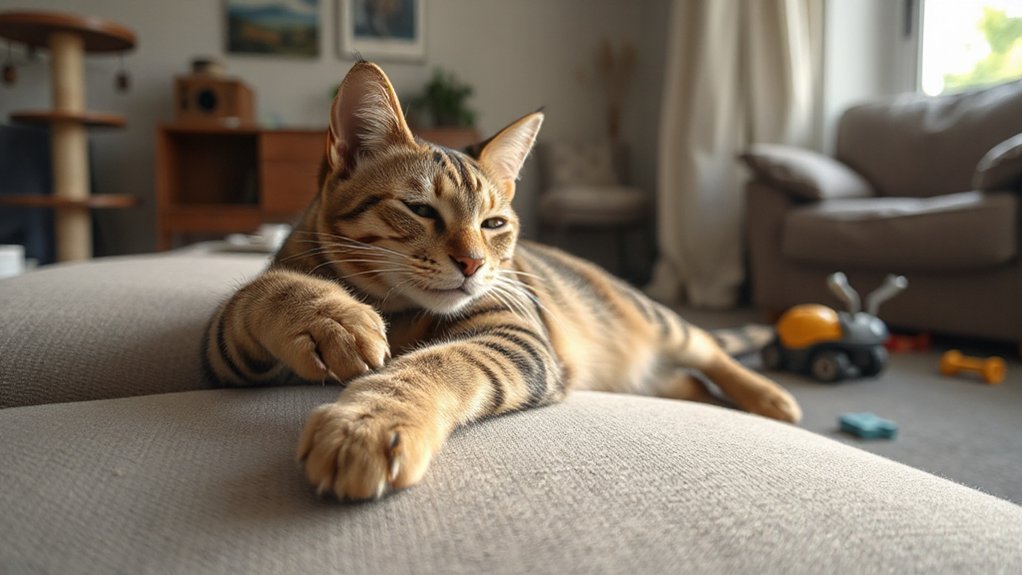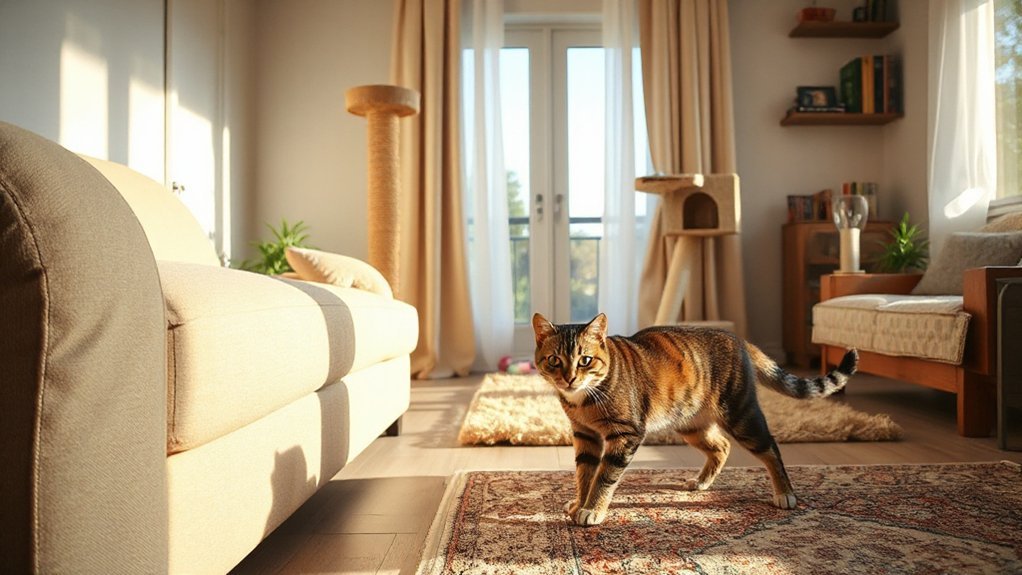You want your cat to stop ruining the couch, but scratching is a normal, important behavior for them. You can change where and how they scratch by offering better options, altering surfaces they target, and using gentle training and nail care. These steps are practical and often quick to apply — and a few adjustments will usually make a big difference if you follow them correctly.
Key Takeaways
- Provide multiple sturdy scratchers (vertical and horizontal) placed near favorite lounging spots and damaged furniture.
- Reward and redirect to acceptable scratchers using treats, praise, or clicker training immediately when your cat uses them.
- Make furniture unattractive with double-sided tape, slipcovers, or furniture protectors while training continues.
- Keep claws trimmed or use nail caps to reduce damage and make scratching less rewarding.
- Consult your veterinarian or a feline behaviorist if scratching suddenly increases or causes bleeding or hair loss.
Why Cats Scratch: Natural Drives and Behaviors

Because scratching serves important biological and communicative functions, cats use it to shed old claw sheaths, stretch muscles and tendons, and mark territory with scent and visual cues. You should recognize scratching as a manifestation of natural instincts and core behavioral needs rather than willful misbehavior. You’ll observe patterns tied to arousal, stress, play, or routine maintenance of claws. When you see a cat scratch, it’s fulfilling sensory and motor requirements and conveying information to other animals. You can respond with measured, humane strategies that respect these drives while protecting belongings. Assess triggers, provide acceptable outlets, and reduce environmental stressors. Your interventions should target underlying motivations, not simply suppress the symptom, so they’re sustainable and maintain your cat’s physical and psychological welfare.
Choosing the Right Scratching Post or Pad

Choose a scratching post or pad that meets your cat’s physical and sensory needs: height and stability for full-body stretches, a surface texture they prefer (sisal, cardboard, or carpet), and a firmness that lets claws sink in without collapsing. Assess scratching post types: vertical posts for stretching, horizontal pads for lying and scratching, and angled posts for mixed use. Evaluate material options against your cat’s preference and durability—sisal rope resists wear, corrugated cardboard is inexpensive and appealing, carpet mimics upholstery but may encourage furniture targeting. Choose robust bases and secure fittings so the unit won’t tip. Offer more than one type to determine preference. Replace or rotate worn surfaces promptly. Monitor usage and respond empathetically: if they avoid it, try a different type or material.
Ideal Placement: Where to Put Scratchers in Your Home

Place scratchers near where your cat lounges most so they’ll be a convenient alternative to your furniture. Put another by doors and windows where they greet the world, and set additional ones in high-traffic rooms to intercept scratching impulses. You’ll reduce damages quickly by making acceptable targets easy to find.
Near Favorite Lounging Spots
Cats prefer to scratch where they spend downtime, so put scratchers right next to their favorite lounging spots — on couches, beside windows, or near armchairs — to redirect the behavior without disrupting their routine. You’ll reduce furniture damage by matching scratcher type and orientation to the location: horizontal pads near sunlit windows, vertical posts beside armchairs. Observe scratching habits to place multiple, small scratchers rather than a single distant one. Use identical materials to what they already prefer and keep scent and texture consistent. Maintain accessibility: don’t block the area with clutter. Clean or replace worn scratchers to sustain interest. Be patient; consistent proximity encourages adoption by aligning with your cat’s comfort and established resting patterns.
By Entry and Exits
Near lounging spots you’ve increased convenience; near entries and exits you’ll manage impulse scratching tied to movement and marking. Place sturdy, vertical scratchers adjacent to doorways and windows — the primary entry points — so your cat redirects instinctive clawing when they come and go. Use short posts or mats that mirror surfaces they target; texture matters. Position scratchers on both sides of frequently used doors if possible, and secure them so they won’t topple when lunged at. Combine placement with scent and reward: rub silvervine or use treats to encourage use. Monitor and adjust: if one spot’s ignored, move the scratcher slightly toward the problem area. These targeted exit strategies reduce territorial marking and protect furniture with minimal disruption to your cat.
In High-Traffic Rooms
When a room sees constant movement, you’ll want scratchers where they’re impossible to miss—along main walkways, beside couches, and near entertainment centers—so your cat can grab a good stretch without detouring to your upholstery. Place one at eye level where your cat greets people and another near seating where it perches. Use vertical and horizontal scratching alternatives to match preference; rotate textures if interest wanes. Keep scratchers stable and scent-marked by rubbing with catnip or feline pheromone spray. Monitor interactions and move units slightly if ignored. Use furniture protectors on items still at risk while training continues. Be consistent: reward use immediately, redirect gently, and reassess placement weekly to guarantee scratchers remain convenient and effective.
Materials and Textures Cats Prefer
You’ll want to match your cat’s instincts by offering surfaces they prefer, like sisal, cardboard, and carpet. Pay attention to texture and resistance—cats favor materials that give when clawed but provide enough grip for a satisfying sink. Also provide both vertical and horizontal options so your cat can express different scratching postures.
Preferred Scratching Surfaces
Cats prefer surfaces that let them sink their claws in and get good resistance—think sisal, corrugated cardboard, rough wood, and tightly woven carpet. You’ll notice individual scratching preferences vary by age, breed, and prior exposure. Offer multiple preferred materials placed near high-use zones: a vertical sisal post by the sofa, a horizontal corrugated pad on the floor, and a wooden scratching board near entry points. Rotate and replace worn pads to maintain appeal. Use consistent positive reinforcement when your cat uses the designated surfaces. Avoid punishing redirected behavior; instead, redirect gently and reward appropriate use. Monitor which preferred materials your cat favors and prioritize those when choosing new or additional scratching options to reduce furniture damage.
Texture and Resistance
Because your cat relies on tactile feedback to decide where to scratch, pick materials that offer both bite and pushback—sisal, rough wood, corrugated cardboard, and tightly woven carpet all provide different degrees of resistance that cats find satisfying. You’ll observe individual scratching preferences driven by texture sensitivity; some cats seek coarse fibers that catch claws, others prefer smooth but firm surfaces that offer steady resistance. Match replacements to observed behavior: if your cat drags and digs, provide dense, fibrous material; if they rake with claws, offer firm, slightly abrasive options. Rotate samples to test responses, record what reduces furniture targeting, and don’t assume uniform preference across cats. Your measured, responsive approach will reduce damage while respecting feline sensory needs.
Vertical vs. Horizontal
Orientation matters: cats use vertical and horizontal surfaces differently, so match replacements to their habitual patterns. You’ll observe vertical scratching when your cat stretches up a sofa or curtain; provide tall sisal posts or wall-mounted pads with coarse, durable fiber that resists claws. For horizontal scratching, offer flat cardboard or low, wide sisal pads that give lateral resistance when they sink claws and pull back.
You should place substitutes where scratching occurs, not only in corners; cats prefer routine locations. Rotate materials if interest wanes, but keep texture consistent: rough, fibrous options for vertical scratching and firm, slightly yielding surfaces for horizontal scratching. Reinforce use with short play sessions and immediate praise; consistent placement and reward reduce furniture damage.
Making Your Furniture Less Appealing to Scratch
While you can’t erase a cat’s instinct to scratch, you can make your furniture a less attractive target by changing texture, scent, and access; cover vulnerable areas with materials cats dislike (like double-sided tape or slick plastic), apply safe deterrent sprays, and block easy routes to preferred spots so scratching feels unrewarding. Use furniture covers on sofas and armrests to create an immediate physical barrier; choose removable, washable options so you can maintain hygiene. Introduce scent repellents that are non-toxic and vet-approved, testing small areas first to ascertain your cat isn’t stressed. Reduce access by rearranging furniture, closing doors, or placing objects that interrupt approach paths. Monitor responses and adjust methods; consistency and humane management reduce damage while respecting natural behavior.
Positive Training Techniques to Redirect Scratching
Start with one clear goal: teach your cat to scratch appropriate surfaces instead of furniture by rewarding desired behavior and redirecting unwanted scratching immediately. You’ll set up accessible scratching posts, observe preferences (vertical vs. horizontal), and mark success with immediate positive reinforcement — treats, gentle praise, or brief play. Use clicker training to create a clear signal: click the moment your cat uses the post, then offer a reward. If they begin on furniture, calmly interrupt and move them to the post; click and reward when they engage. Practice short, consistent sessions daily. Track progress and increase reward intervals as the behavior stabilizes. Stay patient and consistent; cats learn faster with predictable cues and timely rewards.
Using Deterrents Safely and Effectively
One simple rule will keep deterrents safe and effective: choose noninvasive, reversible options and apply them consistently while monitoring your cat’s stress and behavior. You’ll prefer deterrent sprays formulated for cats and furniture—test a small area first, follow label instructions, and reapply only as directed. Pair these with safe alternatives such as double-sided tape, textured covers, or strategically placed scratching posts to offer choices rather than punishment. Watch body language: flattened ears, hiding, or avoidance indicate you should stop and try a different approach. Don’t use bitterants, adhesives, or physical barriers that can injure or trap. Keep records of what you try and results; adjust frequency and placement based on effectiveness. Consult a veterinarian if stress signs persist.
Nail Care: Trimming, Filing, and Soft Claws
Because nails are a primary tool cats use to mark and defend territory, managing them reduces damage and improves comfort for both of you; regular trimming, careful filing, and optional Soft Claws® caps are practical, low-stress strategies you can use at home. You should handle paws gently, praise calmly, and work in short sessions. Learn basic nail trimming to remove only the sharp tip, avoid the quick, and keep a styptic powder nearby. Use filing techniques to smooth edges after clipping or when you prefer a gradual approach. Soft Claws® caps can blunt damage for weeks and require periodic replacement.
- Trim only the white tip; stop before the quick.
- Use a fine file to round edges after clipping.
- Apply Soft Claws® per instructions, replace every 4–6 weeks.
When to Seek Help From a Vet or Behaviorist
If scratching suddenly increases, causes bleeding, or is paired with changes in appetite, litter use, mood, or grooming, don’t wait — consult your veterinarian to rule out pain, skin disease, or neurological issues, and consider a certified feline behaviorist if medical causes are excluded or the behavior persists despite environmental and training efforts. You should seek veterinary intervention when wounds, hair loss, or persistent overgrooming appear, or if your cat shows aggression or marked withdrawal. A structured behavioral assessment helps distinguish stress-driven scratching from medical problems and guides targeted interventions. Expect diagnostics, pain management, and environmental modification recommendations from your vet; a behaviorist will add desensitization training and enrichment plans. Early, coordinated care prevents escalation and improves your cat’s welfare.
Conclusion
You’re not failing—scratching is normal. Provide multiple suitable scratchers (varied textures, vertical and horizontal) near favorite spots, trim nails or use Soft Paws, and cover vulnerable furniture with deterrents like double‑sided tape or protectors. Redirect with positive reinforcement when they use scratchers, and avoid punishment. If scratching’s excessive, sudden, or linked to stress or medical signs, consult your vet or a feline behaviorist for tailored assessment and a safe plan.